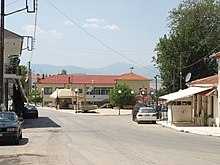Vevi
Vevi
Βεύη | |
|---|---|
 Vevi | |
| Coordinates: 40°46′N 21°37′E / 40.767°N 21.617°E | |
| Country | Greece |
| Administrative region | West Macedonia |
| Regional unit | Florina |
| Municipality | Florina |
| Municipal unit | Meliti |
| Population (2021)[1] | |
| • Community | 498 |
| Time zone | UTC+2 (EET) |
| • Summer (DST) | UTC+3 (EEST) |
| Postal code | 539 74 |
| Area code(s) | 2385 |

Vevi (Greek: Βεύη, before 1926: Μπάνιτσα - Banitsa, before 1928: Μπάνιτσα - Banitsa;[2] Macedonian and Bulgarian: Баница, Banica or Banitsa) is a village located in the municipal unit of Meliti in Florina regional unit, Macedonia, Greece. The village is passed by two national roads which lead to Thessaloniki, Florina, Amyntaio, and Kozani. Additionally, it has a railway station on the line between Florina and Thessaloniki.
Economy[edit]

It is mainly a farming community and is the site of the Achlada, the Vevi lignite mines from Upper Miocene.
History[edit]
The city dates back to Roman times. Archeological finds from this period, such as the marble torso of a male statue, are housed at the Archaeological Museum of Florina.[3]
The local church St. Nicolas was built and painted in 1460.[4] There were 132 Christian households in the village in the first half of the 17th century.[5] In 1845 the Russian slavist Victor Grigorovich recorded Banci as mainly Bulgarian village.[6]
According to local tradition, the settlers who laid the foundation of the modern village included various people from the region such as Greeks, Bulgarians, Turks, etc. There were two Bulgarian schools in the beginning of 20th century.[7]

In 1913, with the conditions of the Treaty of Bucharest, when this part of Macedonia became part of Greece, and after the Balkan Wars, a lot of locals emigrated to Bulgaria. The village was renamed Vevi in 1926.[2] Following World War II as well as the Greek Civil War it saw more exodus on the part of the town's non-Greek inhabitants.
Demographics[edit]
Vevi had 806 inhabitants in 1981.[8] In fieldwork done by Riki Van Boeschoten in late 1993, Vevi was populated by Slavophones.[8] The Macedonian language was spoken in the village by people over 30 in public and private settings.[8] Children understood the language but mostly did not use it.[8]
Transport[edit]
The settlement is served BY Regional and Proastiakos servics to Thessaloniki and Florina.
Notable people[edit]
- Dzole Gergev (1867 - 1909), Macedonian Bulgarian chieftain
- Antigonos Choleris (-1913), Greek chieftain of the Macedonian Struggle and soldier of the Balkan Wars.
- Stavros Kotsopoulos, Greek chieftain of the Macedonian Struggle and soldier of World War II.
- Peter Daicos, Australian AFL footballer whose parents migrated to Melbourne, Australia.
See also[edit]
References[edit]
- ^ "Αποτελέσματα Απογραφής Πληθυσμού - Κατοικιών 2021, Μόνιμος Πληθυσμός κατά οικισμό" [Results of the 2021 Population - Housing Census, Permanent population by settlement] (in Greek). Hellenic Statistical Authority. 29 March 2024.
- ^ a b "Name Changes of Settlements in Greece: Banitsa – Vevi". Pandektis. Retrieved 18 February 2022.
- ^ "Museums of Macedonia, Greece — Archaeological and Byzantine Museum". www.macedonian-heritage.gr. Archived from the original on 2001-07-02.
- ^ Кил, Махиел. Изкуство и общество в България през турския период, София 2002, с. 252.
- ^ Турски извори за българската история, т. VII, София 1986, с. 333
- ^ Григорович, В. Очеркъ путешествiя по Европейской Турцiи, Москва, 1877
- ^ D.M.Brancoff. "La Macedoine et sa Population Chretienne". Paris, 1905, p.176-177.
- ^ a b c d Van Boeschoten, Riki (2001). "Usage des langues minoritaires dans les départements de Florina et d'Aridea (Macédoine)" [Use of minority languages in the departments of Florina and Aridea (Macedonia)]. Strates. 10. Table 3: Vevi, 806; S, M2; S = Slavophones, M = macédonien"

